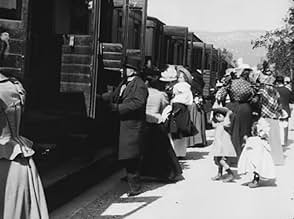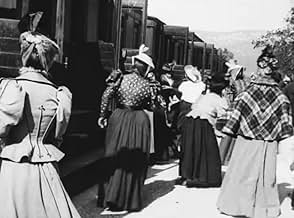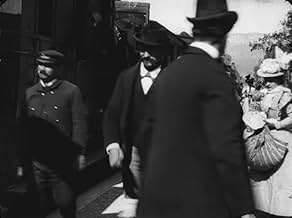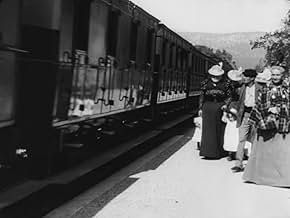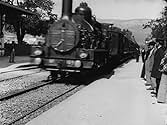CALIFICACIÓN DE IMDb
7.4/10
14 k
TU CALIFICACIÓN
Un tren llega a la estación La Ciotat.Un tren llega a la estación La Ciotat.Un tren llega a la estación La Ciotat.
Opiniones destacadas
A train arrives at a station. And changes everything.
There isn't a lot to really say about L'arrivée d'un train a La Ciotat as a film itself. It's under a minute and shows a train pull up at a busy station. But what it signifies is another thing altogether. When we see that train come closer and closer until it stops in the station, on a surface level we watch a train arrive but it actuality what we are really witnessing is cinema arrive. This short film may not be the earliest movie but it is the first iconic image of the moving picture age.
Auguste and Louis Lumière weren't really artists. Their early films don't stand up to the highly imaginative work of George Méliès for example. But they still remain enormously important cinema giants. Not for the content of their films but for the fact that they kicked things off in the first place and produced the first iconic moment in cinema history. And for this reason L'arrivée d'un train a La Ciotat will always be remembered. Everyone who has a love of cinema should really take a minute of their time to pay homage to the first moment in an amazing journey.
There isn't a lot to really say about L'arrivée d'un train a La Ciotat as a film itself. It's under a minute and shows a train pull up at a busy station. But what it signifies is another thing altogether. When we see that train come closer and closer until it stops in the station, on a surface level we watch a train arrive but it actuality what we are really witnessing is cinema arrive. This short film may not be the earliest movie but it is the first iconic image of the moving picture age.
Auguste and Louis Lumière weren't really artists. Their early films don't stand up to the highly imaginative work of George Méliès for example. But they still remain enormously important cinema giants. Not for the content of their films but for the fact that they kicked things off in the first place and produced the first iconic moment in cinema history. And for this reason L'arrivée d'un train a La Ciotat will always be remembered. Everyone who has a love of cinema should really take a minute of their time to pay homage to the first moment in an amazing journey.
I watched this film on a DVD that was rammed with short films from the period. I didn't watch all of them as the main problem with these type of things that their value is more in their historical novelty value rather than entertainment. So to watch them you do need to be put in the correct context so that you can keep this in mind and not watch it with modern eyes. With the Primitives & Pioneers DVD collection though you get nothing to help you out, literally the films are played one after the other (the main menu option is "play all") for several hours. With this it is hard to understand their relevance and as an educational tool it falls down as it leaves the viewer to fend for themselves, which I'm sure is fine for some viewers but certainly not the majority. What it means is that the DVD saves you searching the web for the films individually by putting them all in one place but that's about it.
Anyway onto this film which is the continuation of the understandable Lumière standard of standing a camera pointing at an event and then recording it happen. In this case a train pulls into a station and people get out. In terms of action it is not that interesting but in regards history of cinema it does offer something at least. It struck me that the other films from Lumiere I had seen to this point had point head on at the action whereas this one was set so that we had a wider view and that things played out across the screen towards the viewer. Also amusing is that some people become awkward when they notice the camera whereas other just bluster in front of it unaware.
The usual fare then that produces little of interest in terms of actual content but has more of interest when viewed in its historical and cultural context.
Anyway onto this film which is the continuation of the understandable Lumière standard of standing a camera pointing at an event and then recording it happen. In this case a train pulls into a station and people get out. In terms of action it is not that interesting but in regards history of cinema it does offer something at least. It struck me that the other films from Lumiere I had seen to this point had point head on at the action whereas this one was set so that we had a wider view and that things played out across the screen towards the viewer. Also amusing is that some people become awkward when they notice the camera whereas other just bluster in front of it unaware.
The usual fare then that produces little of interest in terms of actual content but has more of interest when viewed in its historical and cultural context.
The other reviewers are correct that this is a remarkable piece of history, but it is not the first movie. What film earns that honor depends partly on how you define movies. If you consider Edison's Kinetoscope shorts to be movies, the first movies were from 1893. And even before Edison, there had been some experimentation with projected motion pictures. Even if you give the Lumiere brothers credit for inventing the form (which is a very reasonable decision, but not an inevitable one), I believe their first film was "Workers Leaving The Factory" (aka " Sortie des usines Lumière, La (1895) ") Also, according to the "Oxford History of World Cinema", reports that terrified audience members hid under their seats when the film was first shown are probably apocryphal. Still, this (and the Lumiere brothers other early shorts) are well worth seeing for anyone who loves movies.
At just under a minute, L'Arrivée d'un train à La Ciotat (1895) is one of Louis Lumiere's earliest excursions into film-making. As was formulaic with what he called "actualités," or non-narrative shorts, Louis Lumiere set up his cinematographe (a portable crank-handled camera that triples as a film projector and developer) at such an accomplished angle as to catch the arrival of a train at La Ciotat, where it captures the bustling comers-and-goers of the station who happen to stray in front of the lens, looking altogether curious, or else wary of the unfamiliar contraption. The crowd seems lively enough, but just for good measure, Lumiere's refined wife and mother-in-law can be seen actively searching for an imaginary, but eagerly expected passenger.
As uninteresting as it is (and it IS, even for the most pretentious film buff), L'Arrivée d'un train à La Ciotat's historical appeal is undeniable, if not legendary. The film's effect upon its first public viewing is a well-worn myth told to enthusiastic film students by their professors. Apparently, initial audiences, unaware of film's capacity to fully imitate reality, fled in fear of the image of a train barreling down upon the screen. The French newspaper, Le courrier du centre, (July 14, 1896) alleged the advancing locomotive made "spectators draw back instinctively fearing they'd be run over by the steel monster." Nevertheless, such a widespread and instantaneous physical response seems foolish or naïve even then, especially when the projector would have been visible and the sound audible to all seated in what at that time passed as a "theater." In reality, it is far more likely that this incident was limited to a few isolated cases, and was later exaggerated to enhance its appeal and boost the film's reputation. Consequently, the commerciality of the venture succeeded with tremendous results. Over a hundred years later, not only is L'Arrivée d'un train à La Ciotat a cinematic icon, but proof of how powerful and impressionable moving pictures could (and would) become.
Recommended for those with an interest in film as an art form, or for those looking for early examples of film in history.
As uninteresting as it is (and it IS, even for the most pretentious film buff), L'Arrivée d'un train à La Ciotat's historical appeal is undeniable, if not legendary. The film's effect upon its first public viewing is a well-worn myth told to enthusiastic film students by their professors. Apparently, initial audiences, unaware of film's capacity to fully imitate reality, fled in fear of the image of a train barreling down upon the screen. The French newspaper, Le courrier du centre, (July 14, 1896) alleged the advancing locomotive made "spectators draw back instinctively fearing they'd be run over by the steel monster." Nevertheless, such a widespread and instantaneous physical response seems foolish or naïve even then, especially when the projector would have been visible and the sound audible to all seated in what at that time passed as a "theater." In reality, it is far more likely that this incident was limited to a few isolated cases, and was later exaggerated to enhance its appeal and boost the film's reputation. Consequently, the commerciality of the venture succeeded with tremendous results. Over a hundred years later, not only is L'Arrivée d'un train à La Ciotat a cinematic icon, but proof of how powerful and impressionable moving pictures could (and would) become.
Recommended for those with an interest in film as an art form, or for those looking for early examples of film in history.
This footage of the "Arrival of a Train" is one of the most enduring images of the earliest years of cinema. The often-repeated accounts of the startled reactions to this movie from early audiences, along with the ways that such reactions were commemorated in other early movies such as "The Countryman and the Cinematograph", have made it one of the best-known of the earliest movies, and beyond that, the film in itself accomplishes its own aim very well.
The Lumières discovered very quickly how effective motion towards the camera could be, and that idea is certainly used to good effect here. The diagonal direction of the motion, necessitated by the material being filmed, gives it a distinctive character. Compared with the train, the crowd reactions here are a bit less interesting than they are in some of the other Lumière features that include crowds who know they are being filmed. A couple of them do acknowledge the camera as they go about their business.
Yet even today, the train grabs the viewer's notice, so that the crowd and other details get much less attention. That in itself shows how effectively this enduring classic was able to carry out an interesting idea.
The Lumières discovered very quickly how effective motion towards the camera could be, and that idea is certainly used to good effect here. The diagonal direction of the motion, necessitated by the material being filmed, gives it a distinctive character. Compared with the train, the crowd reactions here are a bit less interesting than they are in some of the other Lumière features that include crowds who know they are being filmed. A couple of them do acknowledge the camera as they go about their business.
Yet even today, the train grabs the viewer's notice, so that the crowd and other details get much less attention. That in itself shows how effectively this enduring classic was able to carry out an interesting idea.
¿Sabías que…?
- TriviaPopular legend has it that, when this film was shown, the audience fled in terror, fearing being run over by the "approaching" train. This legend has since been identified as promotional embellishment, though there is evidence to suggest that people were astounded at the capabilities of the Lumières' cinématographe.
- ConexionesEdited into Louis Lumière (1968)
Selecciones populares
Inicia sesión para calificar y agrega a la lista de videos para obtener recomendaciones personalizadas
Detalles
- Tiempo de ejecución
- 1min
- Color
- Mezcla de sonido
- Relación de aspecto
- 1.31 : 1
Contribuir a esta página
Sugiere una edición o agrega el contenido que falta

